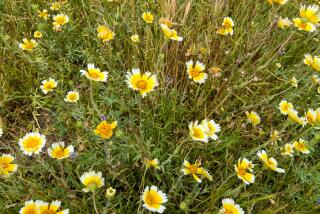Slush: the Southlandâs Surprise Road Hazard
Southern California drivers who abandon the predicted 80-degree heat on Christmas Day and head for the mountains should keep one thing in mind: snow.
Highway safety officials are urging motorists to factor in the possibility of snow over the holidays -- especially at high elevations in Northern California -- and to be prepared.
Just ask the 200 or so motorists who ignored warning signs last January and found themselves trapped for up to 15 hours -- many without tire chains and some dressed in T-shirts -- in a deep, slushy snowpack in the San Bernardino Mountains. Most were headed to the Big Bear resort area.
âItâs true that some of the people of Southern California expect roads to be clear wherever they go,â said Jeffrey Spring, spokesman for the Automobile Club of Southern California. âWhat that case showed is that drivers need to check weather and road conditions and pack up chains and everything else theyâll need on their trip.
âNot all roads around here are like PCH.â
Although Southern California is experiencing a balmy December, Caltrans and the California Highway Patrol say they are preaching preparation as they brace for consecutive busy holiday weekends.
âIâm not trying to scare anyone off, but this is not about just going up some hill to the snow,â Caltrans spokeswoman Terri Kasinga said. âThis is not like driving to work every day.â
The Automobile Club projects nearly 4.4-million Southern Californians will drive 50 miles or more to their holiday destinations during the Christmas and New Yearâs weekends.
The club says the top long-distance driving destinations are San Francisco and Las Vegas, which include sometimes perilous bad-weather routes through the Grapevine or Cajon Pass.
Ski resorts in Lake Arrowhead and Big Bear also will draw thousands of visitors, and with last yearâs debacle in mind, San Bernardino County authorities are urging motorists to check the weather along the route.
Caltrans says motorists can check on road conditions statewide by calling (800) 427-7623.
Authorities say motorists should fill their gas tanks before lengthy trips and have their vehicle inspected -- brakes, cooling system, tire pressure, heater/defroster and engine liquid levels. Drivers should also carry tire chains if either the current conditions dictate their use or if the weather forecast predicts snow during their holiday trip, authorities said. Tire chains should be installed on turnouts or in parking lots, Kasinga said.
âChains cost twice as much up in the mountains, and the [Highland] Wal-Mart will be sold out when it snows,â Kasinga said. âIf youâre a semi-regular traveler to the mountains, you should buy chains.â
The expense of tire chains is annoying, CHP Officer Wally Wood acknowledged. But it is far more irritating, he said, to be stuck like last Januaryâs crowd or be ordered to return down the mountain by officers. Motorists should practice putting on chains before being required to do it on the mountain, Wood said.
The CHP and San Bernardino County Sheriffâs Department will increase patrols along mountain roads. Yet Wood said manpower issues would prevent the CHP from manning foothill posts after 10 p.m. near the road signs that alert drivers whether tire chains are necessary.
Last yearâs backup occurred when late-night motorists ignored the road signs, and accelerated toward the roadblock of slush.
The anxiety of such delays can be eased by packing extra food, water, blankets, medication and clothing, officials said. Although cellphone coverage is spotty in the mountains, the phoneâs battery should be fully charged.
âIf youâre going up there for a day, prepare as if youâll be up there for the weekend, especially if youâre bringing your family,â CHP Officer Rosa Ray said.
Snow driving requires even more caution than driving on wet roads, CHP spokesman Wood said. Drivers should slow to 30 mph on multilane highways, drive three car lengths behind the vehicle in front, drive with headlights on and use brakes lightly.
Studying maps of the area and knowing alternate routes are also important, officials said.
Wood cited the route to Big Bear as an example. Too many motorists from Southern California drive to and from Big Bear City by following highways 330 and 18. Taking Interstate 10 to Highway 38 north is a slightly longer distance but is far faster, especially on holiday weekends, Wood said.
âItâs important to know what your limits as a driver are,â said Spring of the Automobile Club. âThis is an important issue, because the traffic tie-ups and collisions are usually due to people who donât know how to negotiate these mountainous road conditions.
âThese people should know to avoid areas where their limits are going to be exceeded.â
Caltransâ Kasinga declined to criticize the bad-weather driving skills of Southern Californians.
âThe message weâre sending is that we know itâs easy to forget the things weâre asking people to remember,â she said. âWe know everyone works all week, and when itâs time for the holiday weekend, theyâre tired, and they just want to get out of the house. Weâre only asking that everyone look into the conditions before driving up.â
*
BEGIN TEXT OF INFOBOX
Mountain driving
State highway safety officials offer tips for motorists planning long-distance trips over the holidays -- especially in snow-prone areas. Find information on road conditions statewide at www.dot.ca.gov/hq/roadinfo/index.htm or call (800) 427-7623.
--
What to do before traveling
Make sure the vehicle is winter-ready. Tires, brakes, wipers, lights, cooling system, heater and defroster should be checked.
Bring snow chains -- even if the vehicle has four- or all-wheel drive or another type of traction aid -- and know how to put them on. Make sure the chains fit properly.
Park on the side of the road to mount chains.
Carry emergency supplies, including warm clothes, a small amount of food and water, cell phone, medication and blanket.
Fill the gas tank before going into mountainous areas.
--
Winter driving in the mountains
Slow down. In areas that have chain requirements the speed is 25 mph on two-lane highways and 30 mph on multi-lane highways.
Increase your following distance; it takes twice the distance to stop on ice than on dry pavement.
Drive carefully on bridges and in shady areas; the road is more likely to be icy in those areas.
Set the vehicleâs climate control on defrost and use the fresh-air setting; recirculated air fogs the inside of the car.
Be patient and courteous to others on the highway.
--
Sources: Caltrans, California Highway Patrol
More to Read
Sign up for Essential California
The most important California stories and recommendations in your inbox every morning.
You may occasionally receive promotional content from the Los Angeles Times.











